|
Mount Gay Rum
When we were in Fowey at the end of the regatta week, August
2006, we were parked two along from a yacht proudly flying a Mount Gay Rum flag.
I said there and then, it was a 'must do'. We decided to go in style by booking
transport, lunch and tour. A bit naughty as the price was £40.00 each. I
was told on the phone that we had to be in reception at the marina at 10:45 for
an 11:00 pick-up, we were not too bothered for the first half an hour as we are
now in "Caribbean Time". I rang at 11:30 and the lady was very sorry we had been
forgotten and to get a taxi, that they would pay for (£25). En route there was a
traffic jam, no beeping or swearing from anyone, lots of cars and buses turned
round, people let people in, no worries. We arrive for our 12:00 tour at 12:30,
no worries, "join our tour late, do the tasting, eat lunch and join the next
tour for the bits we missed", "Oh and as we have put you out, have one of your
tours for half price. Then we will pay for a taxi wherever you want to go next".
Smashing.
  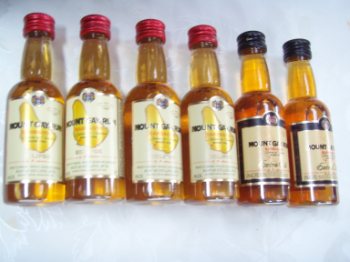
The booty we left with.
Mount Gay Rum is produced by Mount Gay Distilleries Limited of
Barbados. In 2003 the company celebrated its 300th anniversary of the Mount Gay
Rum product which it first produced in 1703, making it one of the oldest. Mount
Gay Rum is sold in 66 countries but the primary market place is the USA. Several
varieties are produced, including White, Extra Old, Flavoured - Mango and
Vanilla, as well as the flagship brand: Mount Gay Eclipse.
On site the bottling plant can bottle 400,000 bottles a day on
the five lines. They never work on Bank Holidays and only work rare weekends if
demand dictates, for which they get double time. The bottling lines operate from
08:00 to 16:30 a day.
Tradition.
Mount Gay Rum is closely associated with sailing. Tales were
told of sailors returning home with a barrel of Mount Gay in order to prove that
they had reached Barbados - considered one of the most difficult islands in the
Caribbean to reach. Today, the Mount Gay Rum Company is one of the main sponsors
of the United States Sailing Association. They also sponsor over 110 regatta
events worldwide, with approximately 50 of those being based in the United
States. Mount Gay is also one of the key ingredients in Stirling Punch, a drink
named for famous yachtsman, America’s Cup winner and Vandebilt Sailing Club
founder Harold Stirling Vandebilt. IF ONLY WE KNEW. Mount Gay sponsor the Fowey
Regatta. Participants are presented with a Red Cap. If you arrive at Mount Gay
Rum with a red cap on you get treated VERY specially.
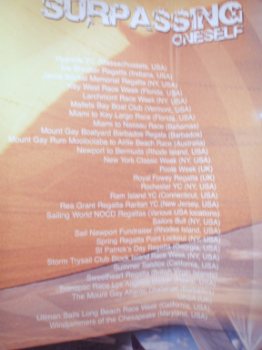  
The list of sponsored regattas,
Fowey in the middle and the coveted red caps.
Mount Gay Sugar Cane Brandy, a careful blend of specially
selected rums of age up to seven years, is a fine product whose link with the
sugar cane of Barbados is proudly reflected in its character. Not to be confused
with generic 'brandy', the product is entirely rum. The name is a legacy from
times when the product contained such a high proportion of double distillate
that its organoleptic characteristics were much like those of brandy. In some
markets, because of legal restrictions, the name 'Sugar Cane Rum' is used in
place of the original name 'Sugar Cane Brandy'. (From the Mount Gay Rum website)
Mount Gay produces a "Pure Sugar Cane Rum" occasionally known outside of the US
market as "Sugar Cane Brandy".
  
Bear with the sniff test of a single
distilled at 98% proof. You have to swirl the alcohol, blow into it and inhale
what comes back at you. On an empty stomach, straight to your head, Marvellous.
In 2007 Mount Gay was rated as being the favourite rum of America's "rich and
famous". The rum was chosen as the winner of the 2007 Luxury Institute's "Luxury
Brand Status Index" (LBSI) survey for premium rum.
|
|
With sugar cane having been so long the lifeblood of Mt
Gay, and one might suggest, of Barbados as well, Its fitting that a great
rum should commemorate its qualities. Sugar Cane Rum is the result
of a rigorous adherence to tradition, a continuing commitment to quality.
A rich amber spirit, with a subtle sweetness, Sugar Cane Rum offers a
harmonious fusion of vanilla and bitter almond in its taste, with a hint
of smoky wood in the nose. The combination is achieved by deft blending of
single distilled and double distilled rums of several ages, and by
meticulous storage in charred oak barrels. The barrels come from Kentucky,
US, and are used to age bourbon before they are used to age Mount Gay
Rum. Such are the qualities of Sugar Cane Rum from Mount Gay. The
world's oldest distillery dating back to 1703. Consistently smooth.
Full bodied. Unique. An homage to the cane.
(Taken from a bottle label) |
|
  
Each liqueur store has to be registered,
the Mount Gay site just happens to be 007. All
liqueur stores on the island are independent, but, if they are painted bright
yellow and red they are sponsored by Mount Gay. The first drink James Bond
orders, thirty minutes into the film, Casino Royale (2006) is not his trademark
martini but a Mount Gay rum and soda. Outside I was wondering if this taxi driver had 'had a few'.
About Rum
There’s nought no doubt so much the spirit calms as rum and
true religion" – Lord Byron
Fifteen men on a dead man’s chest, Yo, ho, ho and a bottle of
Rum. – 17th century 401(k) savings plan for buccaneers
Depending on the recipe, the "wash" (the cane juice, or
molasses and water) is fermented, using either cultured yeast or airborne wild
yeasts, for a period ranging from 24 hours for light Rums up to several weeks
for heavy, full varieties.
Rum Regions
The Caribbean is the epicentre of world Rum production.
Virtually every major island group produces its own distinct Rum style.
Barbados produces light, sweetish Rums from both pot and column stills.
Rum distillation began here and the Mount Gay Distillery, dating from 1663, is
probably the oldest operating Rum producer in the world. Cuba produces
light-bodied, crisp, clean Rums from column stills. It is currently illegal to
ship Cuban Rums into the United States. The Dominican Republic is notable
for its full-bodied, aged Rums from column stills. Guyana is justly
famous for its rich, heavy Demerara Rums, named for a local river, which are
produced from both pot and column stills. Demerara Rums can be aged for extended
periods (25-year-old varieties are on the market) and are frequently used for
blending with lighter Rums from other regions. Neighboring Surinam and
French Guyana produce similar full-bodied Rums. Haiti follows
the French tradition of heavier Rums that are double-distilled in pot stills and
aged in oak casks for three or more years to produce full-flavored,
exceptionally smooth- tasting Rums. Haiti also still has an extensive
underground moonshine industry that supplies the voodoo religious ritual trade.
Jamaica is well known for its rich, aromatic Rums, most of which are
produced in pot stills. Jamaica has official classifications of Rum, ranging
from light to very full-flavored. Jamaican Rums are extensively used for
blending. Martinique is a French island with the largest number of
distilleries in the Eastern Caribbean. Both pot and column stills are used. As
on other French islands such as Guadeloupe, both rhum agricole
(made from sugar cane juice) and rhum industriel (made from molasses) are
produced. These Rums are frequently aged in used French brandy casks for a
minimum of three years. Rhum vieux (aged Rum) is frequently compared to
high-quality French brandies. Puerto Rico is known primarily for light,
very dry Rums from column stills. All white Puerto Rican Rums must, by law, be
aged a minimum of one year while dark Rums must be aged three years.
Trinidad produces mainly light Rums from column stills and has an
extensive export trade. The Virgin Islands, which are divided between the
United States Virgin Islands and the British Virgin Island. Only the US Virgin
Islands still produce Rum, predominately making light, mixing rums from column
stills, although there are some fine dark and aged sipping Rums made by the most
significant producer Cruzan. These Rums, and those of nearby
Grenada, also serve as the base for bay Rum, a classic
aftershave lotion. Guatemala and Nicaragua are noteworthy in
Central America where a variety of primarily medium-bodied Rums from column
stills that lend themselves well to aging. They have recently begun to gain
international recognition. Brazil produces vast quantities of mostly
light Rums from column stills with unaged cane spirit called Cachaça (ca·sha·sa)
the best-known example. Venezuela makes a number of well-respected
barrel-aged golden and dark Rums. The United States has a handful of Rum
distilleries in the south, producing a range of light and medium-bodied Rums
that are generally marketed with Caribbean-themed names. Canada’s
300-year-old tradition of trading Rum for dried cod fish continues in the
Atlantic Maritime provinces of Newfoundland and Nova Scotia where golden Rums
from Antigua, Barbados, and Jamaica are imported and aged for five years. The
resulting hearty Rum is known locally as Screech. Europe is primarily a blender
of imported Rums. Both the United Kingdom and France import Rums
from their former colonies in the Caribbean for ageing and bottling.
Austria is called Inlander Rum. Australia produces a substantial
amount of white and golden Rums. Also Tahiti, Asia, Philippines and
Thailand.
Rum: Its History and Significance
The history of Rum is the history of sugar. Sugar is a sweet
crystalline carbohydrate that occurs naturally in a variety of plants. One of
those is the sugar cane (Saccharum officinarum), a tall, thick grass that has
its origins in the islands of present-day Indonesia in the East Indies. Chinese
traders spread its cultivation to Asia and on to India. Arabs in turn brought it
to the Middle East and North Africa where it came to the attention of Europeans
during the Crusades in the 11th century. As the Spanish and Portuguese began to
venture out into the Atlantic Ocean, they planted sugar cane in the Canary and
Azore Islands. In 1493 Christopher Columbus picked up cane cuttings from the
Canaries while on his second voyage to the Americas and transplanted them to
Hispaniola, the island in the Caribbean that is now shared by Haiti and the
Dominican Republic. Portuguese explorers soon did likewise in Brazil. The
Caribbean basin proved to have an ideal climate for growing sugar cane, and
sugar production quickly spread around the islands. The insatiable demand in
Europe for sugar soon led to the establishment of hundreds of sugar cane
plantations and mills in the various English, Spanish, French, Portuguese, and
Dutch colonies. These mills crushed the harvested cane and extracted the juice.
Boiling this juice caused chunks of crystallized sugar to form. The remaining
unsolidified juice was called melazas (from "miel," the Spanish word for honey);
in English this became molasses. Molasses is a sticky syrup that still contains
a significant amount of sugar. Sugar mill operators soon noticed that when it
was mixed with water and left out in the sun it would ferment. By the 1650s this
former waste product was being distilled into a spirit. In the English colonies
it was called Kill Devil (from its tendency to cause a nasty hangover or its
perceived medicinal power, take your choice) or rumbullion (origins uncertain),
which was shortened over the years to our modern word Rum. The French render
this word as rhum, while the Spanish call it ron.
  
Locally, Rum was used as cure-all for many of the aches and
pains that afflicted those living in the tropics. Sugar plantation owners also
sold it, at discounted prices, to naval ships that were on station in the
Caribbean in order to encourage their presence in local waters and thus
discourage the attentions of marauding pirates. The British navy adopted a daily
ration of a half-pint of 160 proof Rum by the 1730s. This ration was
subsequently modified by mixing it with an equal amount of water to produce a
drink called grog. The grog ration remained a staple of British naval life until
1969. This naval-Rum connection introduced Rum to the outside world and by the
late 17th century a thriving export trade developed. The British islands shipped
Rum to Great Britain (where it was mixed into Rum punches and replaced gin as
the dominant spirit in the 18th century) and to the British colonies in North
America where it became very popular. This export of Rum to North America, in
exchange for New England lumber and dried cod (still a culinary staple in the
Caribbean) soon changed over to the export of molasses to distilleries in New
England. This was done in order to avoid laws from the British parliament, which
protected British distillers by forbidding the trade in spirits directly between
colonies. This law was, at best, honoured in the breech, and smuggling soon
became rampant. The shipping of molasses to make Rum in New England distilleries
became part of the infamous "slavery triangle." The first leg was the shipment
of molasses to New England to make Rum. The second leg was the shipment of Rum
to the ports of West Africa to trade for slaves. The final leg was the passage
of slave ships to the sugar plantations of the Caribbean and South America where
many of the slaves were put to work in the sugar cane fields.

History
The precursors to rum date back to antiquity. Development of
fermented drinks produced from sugarcane juice is believed to have first
occurred either in ancient India or China, and spread from there. An example of
such an early drink is brum. Produced by the Malay
people, brum dates back thousands of years. Marco Polo
also recorded a 14th-century account of a "very good wine of sugar"
that was offered to him in what is modern-day Iran. The first
distillation of rum took place on the sugarcane plantations of the Caribbean in
the 17th century. Plantation slaves first discovered that
molasses, a by-product of the sugar refining process,
can be fermented into alcohol. Later, distillation of these
alcoholic by-products concentrated the alcohol and removed impurities, producing
the first true rums. Tradition suggests that rum first originated on the island
of Barbados. Regardless of its initial source, early Caribbean rums
were not known for high quality. A 1651 document from Barbados stated, "The
chief fuddling they make in the island is Rumbullion, alias Kill-Divil, and this
is made of sugar canes distilled, a hot, hellish, and terrible liquor".
Grades and variations used to describe rum depend on the
location that a rum was produced. Despite these variations the following terms
are frequently used to describe various types of rum:
Light Rums, also referred to as light,
silver, and white rums. In general, light rum has very little
flavor aside from a general sweetness, and serves accordingly as a base for
cocktails. Light rums are sometimes filtered after aging to remove any color.
The Brazilian immensely popular Cachaca belongs to this type. The
majority of Light Rum comes out of Puerto Rico.
Gold Rums, also called amber rums, are medium-bodied
rums which are generally aged. These gain their dark colour from ageing in
wooden barrels (usually the charred white oak barrels that are the byproduct of
Bourbon Whiskey).
Spiced Rum: These rums obtain their flavor through addition
of spices and, sometimes, caramel. Most are darker in colour, and based on gold
rums. Some are significantly darker, while many cheaper brands are made from
inexpensive white rums and darkened with artificial caramel colour.
Dark Rum, also known as black rum, classes as a
grade darker than gold rum. It is generally aged longer, in heavily charred
barrels. Dark rum has a much stronger flavour than either light or gold rum, and
hints of spices can be detected, along with a strong molasses or caramel
overtone. It is used to provide substance in rum drinks, as well as colour. In
addition to uses in mixed drinks, dark rum is the type of rum most commonly used
in cooking. Most Dark Rum comes from areas such as Jamaica,
Haiti, and Martinique.
Flavored Rum: Some manufacturers have begun to sell rums
which they have infused with flavors of fruits such as mango, orange, citrus,
coconut or lime. These serve to flavor similarly themed tropical drinks
which generally comprise less than 40% alcohol, and are also often
drunk neat or on the rocks.
Overproof Rum is rum which is much higher than the standard
40% alcohol. Most of these rums bear greater than 75%, in fact, and preparations
of 151 to 160 proof occur commonly.
Premium Rum: As with other sipping spirits, such as
Cognac and Scotch, a market exists for premium and
super-premium rums. These are generally boutique brands which sell very aged and
carefully produced rums. They have more character and flavour than their
"mixing" counterparts, and are generally consumed without the addition of other
ingredients.
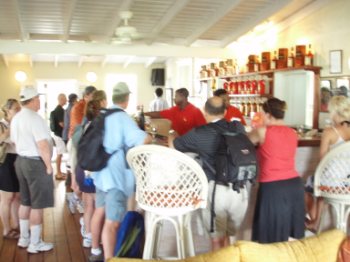 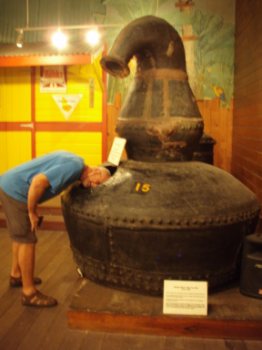 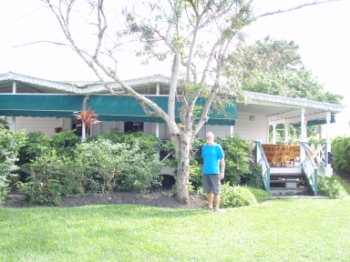
The tasting, we tried Old, Eclipse,
Ponche Kuba (a milky cocktail like Painkiller and a bit like Baileys) and a
fruit/rum cocktail. Bear with his head in a 1760
Pot-still and standing outside where we had
lunch.
Fermentation
Sugarcane is harvested to make sugarcane juice and molasses.
Most rum produced is made from molasses. Yeast and water are added to the base
ingredient to start the fermentation process. While some rum producers allow
wild yeast to perform the fermentation, most use specific strains of yeast to
help provide a consistent taste and predictable fermentation time. Dunder, the
yeast-rich foam from previous fermentations, is the traditional yeast source in
Jamaica. "The yeast employed will determine the final taste and aroma profile,"
says Jamaican master blender Joy Spence. Distillers that make lighter rums, such
as Bacardi, prefer to use faster-working yeasts. Use of slower-working yeasts
causes more esters to accumulate during fermentation, allowing for a
fuller-tasting rum.
Distillation
As with all other aspects of rum production, there is no
standard method used for distillation. While some producers work in batches
using pot stills, most rum production is done using column still distillation.
Pot still output contains more congeners than the output from column stills and
thus produces a fuller-tasting rum.
Aging and blending
Many countries require that rum be aged for at least one year.
This aging is commonly performed in used bourbon casks, but may also be
performed in stainless steel tanks or other types of wooden casks. The ageing
process determines the colouring of the Rum. Rum that is aged in oak casks
becomes dark, whereas Rum that is aged in stainless steel tanks remains
virtually colourless. Due to the tropical climate common to most rum-producing
areas, rum matures at a much faster rate than is typical for Scotch or Cognac.
An indication of this faster rate is the angel’s share, or amount of product
lost to evaporation. While products aged in France or Scotland see about 2% loss
each year, rum producers may see as much as 10%. After ageing, rum is normally
blended to ensure a consistent flavour. Blending is the final step in the Rum
making process. As part of this blending process, light rums may be filtered to
remove any colour gained during ageing. For darker rums, caramel may be added to
the rum to adjust the colour of the final product.
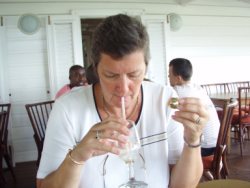
 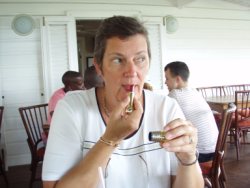 
We went in for our buffet lunch on offer was; coleslaw, salad,
roast chicken, jerk sauce, cocktail sauce, breaded flying fish, battered fish
balls, tropical rice, macaroni pie (macoroni cheese gone firm - yummy)vegetables
of carrot, plantain, pumpkin and swede. For sweet was rum cake (a delicate cake
of the island richly laced with rum) and Rum and raisin ice-cream (I have always
loathed the stuff, but made with real rum not flavouring it was quite
georgeous). We had a jug of water, two fruit rum cocktails and two rum and
Ponche Kuba each. Feeling soporific we felt it was the big photo moment, but
first I had to repair my lippy. Never been able to do
it free hand but alcohol made me brave enough to try.
 
Yipee and with our very own flag to
fly on Beez Neez. Here in Barbados we can buy and drink 43% proof. Overseas law
means they have to water it down to 40%. Lucky us.


Bear tottering out with his booty bag, like
a child leaving a birthday party - but - drunken. Leaning on the post waiting for a taxi into Bridgetown.
ALL IN ALL we
fell out the door and could have stayed in there for several weeks,
their generosity and kindness MORE than made up for the
shaky start.
|



























